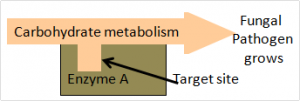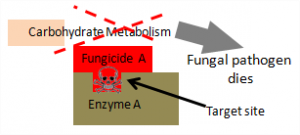The likelihood and speed of resistance development largely depends upon whether the fungicide affects a single metabolic site (single-site) within the fungus or multiple sites (multi-site). A single gene mutation is all that is required for a fungus to overcome the toxic effects of a single-site fungicide. With single gene mutations governing resistance development, the population can shift from mostly sensitive to mostly resistant individuals with just one or two applications of the fungicide. For this reason, single-site fungicides are often considered at-risk or high-risk fungicides.
 |
 |
Most systemic fungicides developed to date have a single-site mechanism of action. It is this specific target of action, rather than the systemic property, that can lead to rapid resistance selection. Multisite fungicides affect multiple target sites, and consequently interfere with numerous metabolic processes of the fungus. Unlike single-gene mutations that confer resistance to single-site fungicides, a simultaneous occurrence of mutations in multiple genes are needed to confer resistance to multisite fungicides. Therefore the risk of resistance to these fungicides is low.
Recognizing that fungicide resistance is a greater problem with some modes of action than with others, the Fungicide Resistance Action Committee (FRAC), an international group that provides guidelines and recommendations to manage the development of fungicide resistance, has assigned risk levels for all classes of commercial fungicides based on mode of action and incidence of resistance in the field (see Spraying by the Numbers). High-risk products have a single site of action or are those for which disease-resistance populations have been discovered. Medium-risk products are associated with fungicides where resistance is seen with the mutation of more than one target site or resistance formation is less frequent than that of high risk. And, low-risk fungicides are characterized by a very rare or undocumented occurrence of resistance after many years of use. The actual risk during commercial use may differ, depending on the target pathogen, location, and fungicide use pattern.
Compiled by Dr. Wayne Buhler, PhD
